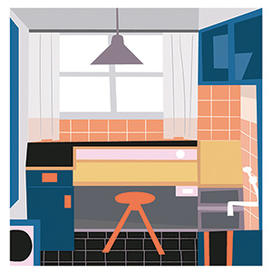S.E. Eisterer Explores Spatial Design
As a child, S.E. Eisterer dreamed of being a writer and was advised to find a topic that she could spend a lifetime writing about. She felt that the city could be a source of endless inspiration and chose to study architecture at the Academy of Fine Arts Vienna in Austria. While her design skills were lacking — “I was a terrible architect” — she found that she enjoyed the writing component of group projects. Wishing to explore urban architecture in cities beyond Vienna, she went to Cornell and pursued a Ph.D. in the history of architecture and urbanism. Eisterer joined Princeton’s School of Architecture as an assistant professor in 2022. This year, she is a senior fellow at the Alexander von Humboldt Foundation in Germany.
Quick Facts
Title
Assistant Professor of the History and Theory of Architecture
Time at Princeton
1 year
Recent Class
Living Room: Gender, Cities, and Dissent
EISTERER’S RESEARCH
A SAMPLING

A Trailblazer’s Legacy
Eisterer’s forthcoming book, Memories of the Resistance: Margarete Schütte-Lihotzky and the Architecture of Collective Dissidence, 1918–1989, traces the long and complex career of architect Schütte-Lihotzky. A native of Vienna, Schütte-Lihotzky is best known for designing the “Frankfurt kitchen” in 1926, the first fitted kitchen designed for maximum efficiency. She was also a member of the Austrian communist resistance against the Nazi regime (and spent five years in prison as a result). Eisterer argues that the Frankfurt kitchen has overshadowed Schütte-Lihotzky’s multifaceted achievements as an architect, which she pursued through “a tri-part practice that rested equally in architectural work, feminist activism, and active resistance labor.”

Beyond Binaries
Eisterer is a member of the Queer Space Working Group, a group of architects and architectural historians who share an interest in new approaches to the study of space. For example, scholars may draw on trans theory, which challenges binary views of the world, to question traditional concepts in architecture, such as “norms that presuppose a standard body.” The group has influenced Eisterer’s own teaching practice, notably in her survey course about architecture and gender, which she recently co-taught with Malcolm Rio of the Rhode Island School of Design (RISD). For their final project, rather than a traditional academic essay, students created their own zines, a format that encourages students to think creatively and “bring their embodied knowledge to the act of writing.”

New Publications
Eisterer is editing a forthcoming book titled Living Room: Architecture, Gender, Theory, which brings together queer and feminist writings on architecture. Eisterer hopes that the book will be a useful resource for students who are new to architecture. “When I started, I wish there [had] been a book like this,” she says. With Ana María León Crespo of Harvard, she is also editing a book titled No Small Acts: Spatial Histories of Unfreedom and Resistance.
The book considers how people have used ephemeral objects, landscape cities, and other architectural forms as a means to resist oppression. For example, women imprisoned by the Nazis for their participation in the resistance secretly saved scraps from the rag rugs they were forced to make and fashioned them into slippers, symbolizing their hope to one day walk to freedom.












No responses yet